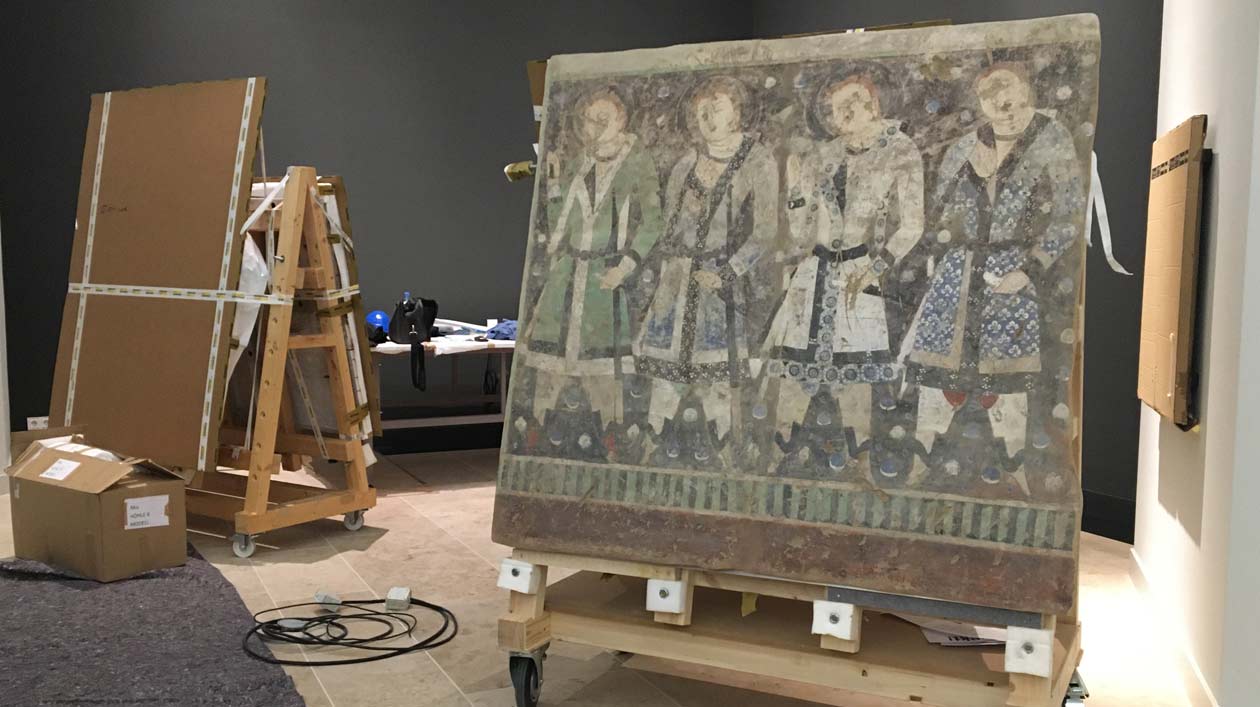Sword Bearers Under a Dome
News from 09/02/2020
It has taken three separate shipments to bring the original wall paintings from Dahlem to the Humboldt Forum, where over the next few months they will be brought together in a partial reconstruction of the Cave of the Sixteen Sword Bearers – the first time that they can be seen as a unified composition in over a hundred years.

On the third floor of the Humboldt Forum, an imposing white dome spans exhibition architecture inspired by the colors of the Silk Road and the rugged landscape around Kizil in China’s Xinjiang region. Here, in one of the most architecturally striking halls of the Humboldt Forum, visitors will soon be able to experience the Cave of the Sixteen Sword Bearers, one of the major highlights of the exhibition area. In the building's neighboring South Cube, the Cave of the Ring-Bearing Doves is currently being completed. Visitors will later be able to walk inside it. These two caves form a unique ensemble.
Caves like these, with frescoes dating from between the fifth and eleventh centuries, were originally part of a Buddhist temple complex, where they served as accommodation and sanctuaries for the monks. They were hollowed out from the relatively soft rock of the mountains, and their stony walls were covered with a coarse layer of clay plaster. A second, finer layer of clay plaster formed the base for the white gypsum plaster ground. Then the preliminary drawings were made with charcoal sticks, sometimes using stencils. Some of the preliminary drawings bear characters from the Tocharian alphabet, which has since died out. These were inserted to indicate the colors of various parts of a painting, executed in the tempera technique. Gold was often applied for enhancement.
Both of these cult caves were discovered in the course of the four Prussian expeditions to Turfan between 1902 and 1914, under Albert Grünwedel (1856–1935), who was then the director of the Indian department of the Royal Museum of Ethnology. After being detached in 1914, the secco paintings were taken to Berlin, where they were conserved and restored before being exhibited in the museum until 1939. The Cave of the Ring-Bearing Doves was presented as a simplified square cult room, but lack of space meant that only individual paintings from the Cave of the Sixteen Sword Bearers could be displayed. After the World War II, these parts of the collection ended up in Dahlem. There, too, only the Cave of the Ring-Bearing Doves was presented as a unified group. Between 1997 and 2000, the Museum für Indische Kunst (Museum of Indian Art) had it scientifically examined, extensively restored, and then reconstructed according to the original dimensions.
In the years that followed, the restorers began various projects to study the second Buddhist cult cave in detail, working together with art historians and in cooperation with their counterparts in China. They developed a concept for the structure in the Humboldt Forum, based on the original space's dimensions. These caves are unique examples of their kind in the world's museums. Representing the life and death of the Buddha, these archaeological treasures also offer insights into far-reaching cultural and artistic relationships along the Silk Road.

